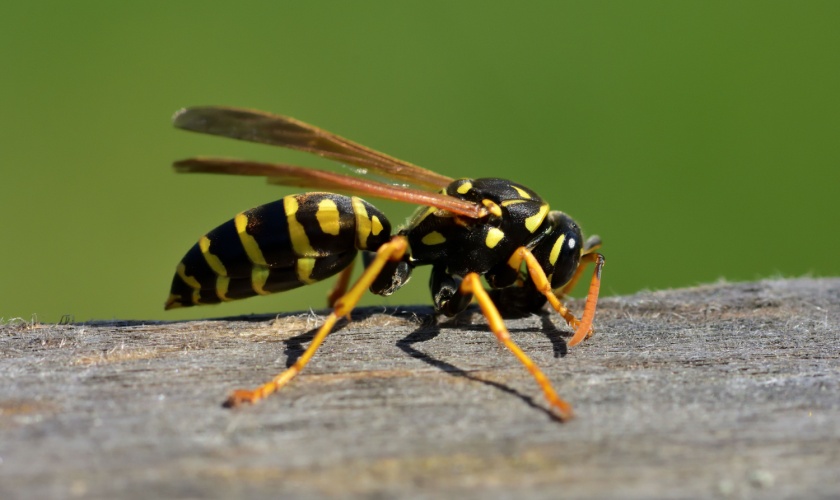You’re just trying to enjoy the backyard—and out of nowhere, a wasp zips by your head. Now you’re on high alert, scanning every corner for the nest. Sound familiar?
Wasps don’t wait for an invitation. They’ll build under eaves, in garden sheds, even underground—and once they’re in, they tend to stick around. They can turn a relaxing afternoon into a no-go situation quicker than you’d think.
Here’s a step-by-step breakdown to help you spot trouble early, reduce risk, and decide when it’s time to bring in the pros.
Step 1: Recognize the Early Signs
Wasps are often mistaken for bees, but there are key differences. Look out for:
- Thin-waisted, smooth-bodied insects with bright yellow and black markings
- A steady flow of wasps flying to and from a specific area of your yard
- Visible nests under eaves, tree branches, behind shutters, or even underground
- Increased aggression, particularly when you approach nesting areas
- Hovering near food, drinks, or trash bins, especially in warmer months
If you’re observing one or more of these signs, you’re likely dealing with a growing wasp infestation in Copperas Cove or your local area.
Step 2: Make Your Yard Unwelcoming to Wasps
Before diving into traps and treatments, tackle what’s attracting them. Start by:
- Sealing and securing garbage bins and compost to eliminate food sources
- Cleaning up spills and crumbs from outdoor meals right away
- Keeping pet food indoors or only bringing it out during feeding time
- Trimming back dense shrubs or tree branches that offer prime nesting sites
- Planting wasp-repellent herbs, like mint, citronella, or eucalyptus, around patios and porches
These small changes create a more hostile environment for wasps—and a more enjoyable one for you.
Step 3: Stay Ahead with Smart Prevention
If you want to keep wasps from moving in, start before they even arrive. Early-season prevention makes a real difference. Here’s how:
- Hang decoy wasp nests around eaves or corners—they’ll often avoid areas already “claimed”
- Set traps in spring when scout wasps begin searching for nesting sites
- Apply natural repellents using oils like clove, lemongrass, or geranium mixed with water
- Target entry points such as small cracks near decks, vents, or under siding
Taking these steps early helps cut off wasps before they see your yard as prime real estate.
Step 4: Don’t Take Chances with Active Nests
If you’re already seeing high activity and spot a nest, it’s time to proceed with caution. Wasps defend their colonies aggressively. Stings can be painful—and in some cases, even life-threatening for allergic individuals.
It may be tempting to try DIY solutions, but using the wrong product at the wrong time can make the situation worse. Avoid flooding, burning, or swatting the nest. If you’re going to attempt treatment, always do it at night when wasps are dormant, and wear proper protective gear. But truthfully, this is the kind of job better left to trained professionals.
Step 5: Seal the Entry Points
Many people forget that wasps don’t just build in trees—they can get inside walls, attics, or behind siding. That’s why it’s important to do a quick inspection and seal any small cracks or crevices they might use to access indoor areas. Check screens, rooflines, vents, and door frames. Even a pencil-sized gap is an open invitation.
This step isn’t just about safety; it’s about long-term peace of mind.
Step 6: Teach the Family Wasp Safety
Awareness is a simple yet powerful line of defense. Make sure children and guests understand how to act around wasps. Encourage calm behavior, show them which areas to avoid, and keep allergy medication within reach if needed. Something as small as leaving a sugary drink uncovered during a barbecue can spark an entire swarm.
Small behavioral shifts can help avoid panicked reactions—and panicked reactions often lead to stings.
The Point Where Professionals Matter
You’ve done what you can—cleaned, patched, trimmed, sprayed. But wasps are still showing up like they own the place. That’s the moment to stop troubleshooting and start trusting a pro.
Some nests are out in the open. Others? Hidden in wall voids, tucked under siding, buried underground, or built high in rooflines where they’re easy to miss and risky to reach. And the more you poke around, the more aggressive they get.
That’s where experience makes all the difference. Professional wasp control isn’t just faster—it’s safer. We know the species, the nesting patterns, and the best way to eliminate the problem without putting your family, pets, or property in harm’s way. We also look beyond what’s visible—tracking entry points and attractants to stop the cycle for good.
It’s not about giving up—it’s about leveling up. When wasps don’t back down, calling in expert help isn’t a last resort. It’s the smartest, safest move you can make.
Because Comfort Shouldn’t Come with a Sting
There’s a big difference between living with nature and feeling like it’s taking over your life. When wasps move in, they don’t ask permission—and suddenly, your backyard becomes a no-go zone. Those peaceful moments on the patio, family dinners outdoors, even letting the kids run free—everything’s at risk with just one aggressive nest.
DIY tactics may offer temporary relief, but wasps are persistent. They find new corners to hide, rebuild overnight, and quickly adapt to store-bought sprays and traps. What you need isn’t another product—it’s a plan. One that’s customized, experienced, and focused on lasting protection.
At Endeavor Pest Management, we do more than remove nests—we restore peace. As a veteran-founded, family-first company, we show up with heart, discipline, and deep local insight into Central Texas pests. You’ll get expert care from people who care like neighbors—because that’s exactly who we are.
We’ll show the wasps the door and bring comfort home again. More playtime, less panic. That’s what we’re here for.

